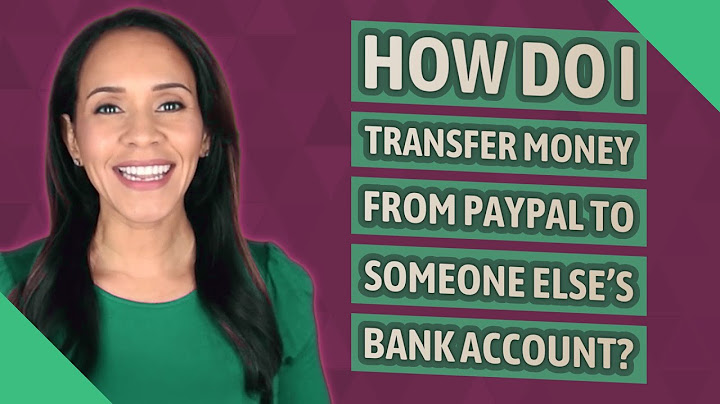ON THIS PAGE Jump to Open page navigation Show You may be looking for the best way to deposit money into another person’s bank account, whether you wish to pay a friend back or give some birthday cash to a relative. Fortunately, there are several options available, whether you’re looking to deposit the funds electronically or in person at a bank branch. 1. Deposit cash at the bankYou can put cash into someone else’s account by going to a bank where the person holds an account and giving the teller the person’s name and account number. Some banks, however, don’t let you deposit cash into someone else’s checking account. They include the three biggest banks — JPMorgan Chase, Bank of America and Wells Fargo. As the banks see it, the decision to ban cash helps prevent money laundering and fraud — cash is hard to trace, after all. It’s also expensive to process. Though you might feel inconvenienced, there are alternatives — some of which are quicker than depositing cash into someone else’s account at a branch. 2. Make an electronic transferYou can easily transfer money into a friend or relative’s account through a service such as Venmo, PayPal or Cash App. You can also move money to others through Zelle — and since most banks already include Zelle in their offerings, you won’t likely need to sign up for this service separately. Take precautions when using any of these digital options. When you send money to someone else through these kinds of services, the payments are often irrevocable. Only send money to people you know and trust to avoid falling victim to a scam. If your bank doesn’t offer Zelle, you can still send an electronic bank transfer through your online banking account by entering the recipient’s bank account number and routing number. Though Zelle moves money in minutes, this kind of bank-to-bank transfer can take a few days. 3. Make a wire transferA wire transfer is another option for transmitting money to someone else’s bank account. Wire transfers can be done at banks, credit unions, or providers such as Western Union or Wise. To conduct a wire transfer, you’ll usually need the account number, routing number and name of the recipient. Wire transfers may be your best bet for sending large amounts of money, as those done through a bank often don’t have limits, as long as you have enough funds in your account. What’s more, domestic wire transfers are often conveniently processed the same day, sometimes within a matter of hours. Wire transfers can be pricey, however, compared to fee-free services like Zelle. Fees for domestic outgoing wire transfers can cost as much as $35, while international ones tend to range from $35 to $50. 4. Write a checkThough paper checks are falling out of favor, you can still deposit a personal check into someone else’s bank account. Checks pose less of a threat to banks than cash deposits because financial institutions can trace the money with a check. “The key question is always: ‘Where did you get that money?” says Marc Trepanier, principal fraud consultant at ACI Worldwide, a software provider. “With a check, we know where it came from. It came from another account.” Just like cash, a check can be deposited into another person’s account at a branch when you present it to the teller, along with the recipient’s name and account number. Unlike cash, the downside is your bank won’t always make the funds available immediately. “The check can clear and settle in hours depending on the circumstances,” says Bob Meara, senior banking analyst at Celent, a financial-services research and consulting firm. “But most banks wait a business day for funds availability for most customers simply so they can see if the check clears.” 5. Use a cashier’s checkInstead of writing a personal check, you can deposit a cashier’s check into someone else’s bank account. You can obtain a cashier’s check — also known as an official bank check — by paying the bank upfront for the full amount of the check. The bank then creates the check for the requested amount and lists the intended recipient as the designated payee. The benefit of a cashier’s check is there is no risk of it bouncing, since it’s backed by the issuing bank’s funds, and a cashier’s check usually clears more quickly than a personal check. 6. Use a money orderIf you don’t want to use a personal or cashier’s check to deposit money into someone else’s account, using a money order is an alternative, old-school option. Like a check, a money order is a paper document that provides funds, but it’s not tied to a bank account. You can buy a money order at banks and credit unions, post offices, chain drug and grocery stores, and some big-box retailers. There is a cost, but money order service fees are relatively cheap. For instance, the U.S. Postal Service charges $1.45 for domestic money orders up to $500. The money order comes with a receipt, and even if it is lost or stolen, a money order can typically be replaced. Like cashier’s checks, money orders are prepaid, so there’s no risk of them bouncing. See what other banks offerThere are plenty of ways to deposit funds into the account of a friend or relative. Not every bank allows for all methods, so if your bank doesn’t offer the service you find easiest or need to use, it may pay to switch banks. What’s more, a different bank may offer other perks, such as better rates on CDs, savings accounts and mortgages or even a more useful mobile app. “Look for the bank that is known as being the most consumer centric,” says Ciaran Chu, head of cloud transformation at ACI Worldwide. Bottom lineMoving money into another person’s bank account can be quick and inexpensive with electronic options like Zelle, Venmo and wire transfers. Old-school alternatives — such as depositing cash, checks or money orders in person — are also still viable options, although they may require more processing time and a trip to the bank. –Senior editor Mary Wisniewski contributed to this article. How do I send money directly to someone's bank account?You can transfer money electronically through websites and apps such as Venmo, PayPal, and Zelle. You may send a money order for amounts smaller than $1,000, or a cashier's check for larger amounts.. PayPal.. Square Cash.. TransferWise.. Venmo.. Zelle.. How can I transfer money to another person instantly?Best Methods for Quickly Transferring Money. Zelle. Zelle can be used online, through the Zelle mobile app or through participating banks' online banking platforms. ... . PayPal. PayPal lets you send, request or collect money online or with the PayPal app. ... . Venmo. ... . Western Union. ... . Walmart2Walmart.. |

Related Posts
Advertising
LATEST NEWS
Advertising
Populer
Advertising
About

Copyright © 2024 moicapnhap Inc.


















